Kevin Behan - Your Dog Is Your Mirror
Here you can read online Kevin Behan - Your Dog Is Your Mirror full text of the book (entire story) in english for free. Download pdf and epub, get meaning, cover and reviews about this ebook. publisher: New World Library, genre: Detective and thriller. Description of the work, (preface) as well as reviews are available. Best literature library LitArk.com created for fans of good reading and offers a wide selection of genres:
Romance novel
Science fiction
Adventure
Detective
Science
History
Home and family
Prose
Art
Politics
Computer
Non-fiction
Religion
Business
Children
Humor
Choose a favorite category and find really read worthwhile books. Enjoy immersion in the world of imagination, feel the emotions of the characters or learn something new for yourself, make an fascinating discovery.
- Book:Your Dog Is Your Mirror
- Author:
- Publisher:New World Library
- Genre:
- Rating:3 / 5
- Favourites:Add to favourites
- Your mark:
- 60
- 1
- 2
- 3
- 4
- 5
Your Dog Is Your Mirror: summary, description and annotation
We offer to read an annotation, description, summary or preface (depends on what the author of the book "Your Dog Is Your Mirror" wrote himself). If you haven't found the necessary information about the book — write in the comments, we will try to find it.
Your Dog Is Your Mirror — read online for free the complete book (whole text) full work
Below is the text of the book, divided by pages. System saving the place of the last page read, allows you to conveniently read the book "Your Dog Is Your Mirror" online for free, without having to search again every time where you left off. Put a bookmark, and you can go to the page where you finished reading at any time.
Font size:
Interval:
Bookmark:

YOUR MIRROR
YOUR MIRROR
OF OUR DOGS AND OURSELVES
KEVIN BEHAN


Copyright 2011 by Kevin Behan
All rights reserved. This book may not be reproduced in whole or in part, stored in a retrieval system, or transmitted in any form or by any means electronic, mechanical, or other without written permission from the publisher, except by a reviewer, who may quote brief passages in a review.
Text design by Tona Pearce Myers
Library of Congress Cataloging-in-Publication Data
Behan, Kevin.
Your dog is your mirror : the emotional capacity of our dogs and ourselves / Kevin Behan.
p. cm.
Includes bibliographic references.
ISBN 978-1-57731-696-1 (hardcover : alk. paper)
1. Dogs Behavior. 2. Human-animal relationships. I. Title.
SF433.B437 2010
636.7 dc22 | 2010042715 |
First paperback printing, March 2012
ISBN 978-1-60868-088-7
Printed in the USA on 100% postconsumer-waste recycled paper

10 9 8 7 6 5 4 3 2 1
To my heart:
Cara, Sean, Sondra, and Agi
If men would seek what is best to do in order to make themselves worthy of that toward which they are so attracted, they might have dreams which would purify their lives. Let a man decide upon his favorite animal and make a study of it, learning its innocent ways. Let him learn to understand its sounds and motions. The animals want to communicate with man.
Brave Buffalo, Teton Sioux, circa 1896
Rosy is a female cocker spaniel owned by Linda, a psychotherapist, and Rosys story exemplifies much of what this book is about. Linda arrived at my farm with Rosy riding in the front passenger seat of a luxury performance car that was freshly washed and waxed and somehow still sparkling after traveling the mile of muddy dirt road to my farm. The car was upholstered and trimmed in bright, clean leather, its interior immaculate. When Linda opened the door, Rosy spilled over her lap and washed up onto me like a wave of bubbling friendliness. Then the dog took to the ground and kept in constant high motion, extending her retractable leash out as far as it would go, straining her way into the muck at the edge of the drive. Linda managed a quick hello but was for the most part absorbed in keeping up with Rosy, who was nose-deep in a thousand new scents, her head rising up from time to time to scan the far horizon, toward which shed zoom off anew. I winced when I thought about her dirty paws tracking back in over the cars showroom-perfect surfaces. Somehow I knew Linda wouldnt mind.
Eventually we got organized, and as is my custom, we began our consultation with a trail walk through our property. The trail is the remnant of an old stage road that once transected Vermont on its way to Albany, New York. It travels through the woods for the better part of a mile and then empties into a field overlooking an abandoned beaver pond. It often takes getting to the end of this road for some dogs and some owners to unwind. Some of the dogs splash in the water, some forage around looking for sticks, some eat grass, some stare into the woods. After a few minutes of taking in the view, we head back.
As we walk along I write down in my notebook everything Linda has to say. Occasionally I answer a question she asks, but I do so as briefly as possible. I dont want to put anything I have to say ahead of what Linda is here to tell me.
When I used to work for my father, John Behan, at Canine College in West Redding, Connecticut, I might spend hours interviewing a customer about how they raised and trained their dog. Just like my father and the other staff trainers, I tried to pinpoint the exact moment when the dog learned this or that association, developed this or that bad habit, or when and how the owner began to slip as a leader in their dogs eyes. The consultation started the instant the owner took their dog out of the car. Dad taught me to watch closely to see who was in charge the parents, the kids, or the dog?
Today, I still ask customers the same questions that I asked thirty-five years ago: How old was your dog when you got her? What has been your approach to discipline? When did you first notice the problem? But even though I ask the same questions and can end up talking for just as long as when I first started, Im no longer looking for information about the dogs background or how she learned this or that behavior. Im not trying to place the dog in the so-called pack hierarchy. Theres nothing more I need to know about Rosy; she has revealed herself during the first few minutes of our encounter. Rather, I ask questions and write down Lindas remarks to encourage Lindas thinking, reminiscing, and speculating, because as Linda talks about Rosy, her deepest feelings surface in her choice of words, the tone of her voice, and where her emphasis falls in a sentence. What matters to me is how Linda sees her dog, how she interprets Rosys behavior, and most important, how Rosy makes Linda feel.
Rosys problem is aggression toward children, but her behavior is characterized by a particularly frenzied and conflicted state. There is tail wagging even as she lunges and snarls, with no question she will bite although so far Linda has managed to negotiate the roiling waters without any child getting hurt. I find it interesting to hear from Linda that in the middle of Rosys furious fusillades can be heard a high-pitched screaming series of barks that culminates in a choking, gagging sound, as if she had something stuck in her throat.
Linda has already tried to solve this problem. Shes tried training according to the dominance model, and training in the science of behavior modification; shes implemented the no free lunch regime wherein a dog has to work for every pleasure rather than getting a free ride, what I would call subsidizing inefficiencies. Shes tried a head-halti, which is a type of head halter somewhat like what a horse wears. It tightens around a dogs snout, mimicking how a mother dog disciplines her pups. The theory is that this is a natural way dogs learn to respect the guidance of an authority figure. So far nothings helped beyond some short-lived gains. Recently Linda has begun dating a man who has a young son, and so the strategy of avoiding children as a way of managing the problem is no longer feasible. Rosy must now learn to live with kids.
After our walk we end up sitting at my kitchen table. While Linda sips tea I hold Rosy on a lead, and she strains to get to every corner of the kitchen. Linda, noticing our dogs water bowl by the fridge, asks if perhaps Rosy wants some water. I find this an interesting suggestion given that we have just walked past a running stream, a pond, and all manner of standing water. I let Rosy go to the water bowl, which she sniffs, but in an instant her attention diverts to a new avenue of investigation. Our corgi dog, Barley, wanders in to see whats going on. The two dogs touch noses, and then, uncharacteristically, Barley breaks away and goes to the front door. Linda, half rising from her chair, asks if perhaps Barley wants to go outside. She doesnt know Barley is avoiding Rosy because of what hes picked up in that one instant.
Next pageFont size:
Interval:
Bookmark:
Similar books «Your Dog Is Your Mirror»
Look at similar books to Your Dog Is Your Mirror. We have selected literature similar in name and meaning in the hope of providing readers with more options to find new, interesting, not yet read works.
Discussion, reviews of the book Your Dog Is Your Mirror and just readers' own opinions. Leave your comments, write what you think about the work, its meaning or the main characters. Specify what exactly you liked and what you didn't like, and why you think so.












